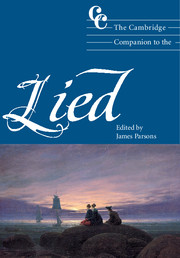Book contents
- Frontmatter
- Part I Introducing a genre
- Part II The birth and early history of a genre in the Age of Enlightenment
- Part III The nineteenth century: issues of style and development
- Part IV Into the twentieth century
- 12 The Lieder of Mahler and Richard Strauss
- 13 The Lied in the modern age: to mid century
- Part V Reception and performance
- Index
12 - The Lieder of Mahler and Richard Strauss
from Part IV - Into the twentieth century
Published online by Cambridge University Press: 28 September 2011
- Frontmatter
- Part I Introducing a genre
- Part II The birth and early history of a genre in the Age of Enlightenment
- Part III The nineteenth century: issues of style and development
- Part IV Into the twentieth century
- 12 The Lieder of Mahler and Richard Strauss
- 13 The Lied in the modern age: to mid century
- Part V Reception and performance
- Index
Summary
If one can describe the first half of the nineteenth century as a golden age of Lieder, it is understandable that composers in the century's second half found the inevitable comparisons with that period to be challenging. For once, it was not the long shadow of Beethoven that overawed, given that the feelings of inadequacy he engendered mostly affected instrumental music. As Brahms revealed during the long gestation of his First Symphony, completed in 1876 at the age of forty-three, “never compose a symphony! You have no idea how it feels … when one always hears such a giant marching along behind.” In the area of song, the source of anxiety stemmed from an altogether different source. As Brahms remarked a decade later in 1887,
The true successor to Beethoven is not Mendelssohn … nor is it Schumann, but Schubert. It is unbelievable, the quality of music contained in these songs. No composer understands as he does how to set words properly. With him perfection is always so naturally the outcome that it seems as if nothing could be otherwise … In comparison to Schubert everything is botching.
Brahms himself risked such comparison in his own Lieder, none of which could fairly be described as botched. This aside, there can be little doubt that the second half of the nineteenth century was so influenced by the past that it raises the question of the impact that increasing historicism had on creativity. Such a perspective comes to bear in a chapter devoted to the Lieder of Gustav Mahler (1860–1911) and Richard Strauss (1864–1949), since both composers seem to sum up their historical positions while simultaneously moving beyond them. The young Mahler, in turning to the Lied in the 1880s through the agency of his beloved Des Knaben Wunderhorn (The Youth’s Magic Horn), looks beyond Schubert to some earlier idea of German folk song, just as the elderly Strauss, in his Vier letzte Lieder, with the rubble of World War II around him, invokes a sound world impossible to describe adequately: tempered by the times he had survived, steeped in the traditions of the Romanticism that shaped him, but not truly part of either.
- Type
- Chapter
- Information
- The Cambridge Companion to the Lied , pp. 243 - 272Publisher: Cambridge University PressPrint publication year: 2004

